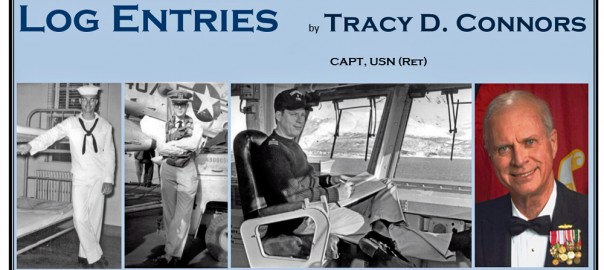PerGra, Blow Tubes
While the watch team calculated the “blow time” in the middle of the turn for Main Control, I alerted them that we were about to grant permission. However, the window for blowing tubes was narrow…in the middle of a turn…and that engineering should be ready to let ’em rip…immediately after the PerGra (permission granted) was given on the 21 MC announcing system. They Rogered.

In a few minutes, AFTER clearing one of our jets to make a high speed, low altitude “pass” [think Top Gun] over the “trawler” that was bristling with antennae, and at the time calculated by the watch team, I punched down the buttons on the 21 MC, “Main control, Bridge, permission granted to blow tubes…NOW!”
Seconds later heavy clouds of choking soot from around countless boiler tubes boiled out of the stack and began drifting rapidly downwind…and towards the wallowing “trawler.”
The watch team cheered, we even heard cheering from PriFly aft of our level.
The Captain was happy, the bridge watch team was ecstatic, Main Control had “gotten into the War,” and I wrote in my deck log: “Blew tubes at 1430.”
Kiss Our Ash, Comrade!
© Copyright 2017-2022 BelleAire Press
Other works by Dr. Connors…
Baited Trap, the Ambush of Mission 1890
Now Available As E-Pub

Baited Trap, The Ambush of Mission 1890 is the story of helicopter rescue Mission 1890, one of the most heroic—and costly—air rescues of the Korean War. This harrowing Air Force-Navy mission is explained in compelling detail, creating a detailed personal account of what five incredibly brave and determined Air Force and Navy airmen achieved on June 25, 1952 in the infamous “Iron Triangle.”
The Korean War’s Greatest Love Story
Baited Trap is much more than a heroic war story from the “forgotten war.” It is also the Korean War’s greatest love story, following Wayne and Della Lear, Bobby Holloway, Ron Eaton and Dolly Sharp, and Frankie and Archie Connors as they tried to put their lives and families together even as the Korean War was reaching out to engulf them.
Truckbusters From Dogpatch: the Combat Diary of the 18th Fighter-Bomber Wing in the Korean War, 1950-1953

Truckbusters from Dogpatch is the most comprehensive Korean War unit history yet prepared–over 700 pages summarizing squadron histories and first person accounts—and includes over 1,000 never before published photographs and images, highlighted by the 8 ½ x 11-inch format.
Arguably, Truckbusters From Dogpatch is the most authoritative unit history ever prepared on the Korean War. In addition to consulting formerly classified squadron histories filed monthly throughout the conflict, the author was in touch with hundreds of veterans of the 18th—pilots and ground crew—whose personal recollections add vivid detail and emotion to the facts recounted in the official documents.
Recent Log Entries by CAPT Connors…
Carrier Captain’s Night Orders: “Call Me…”
After reading these Night Orders you can better appreciate what training, attention to duty, and vigilance was required by underway watchstanders in those days. What has changed since then that has resulted in the recent tragic collisions between U.S. Navy ships and other vessels?
“We do it all!” (USS Saipan LHA-2 motto)
Saipan CO, CAPT Jack Renard, was not exaggerating when he noted that “without exception, SAIPAN is the most versatile instrument of peace or war on the seas today.” Like its motto pointed out, SAIPAN could do it all.
